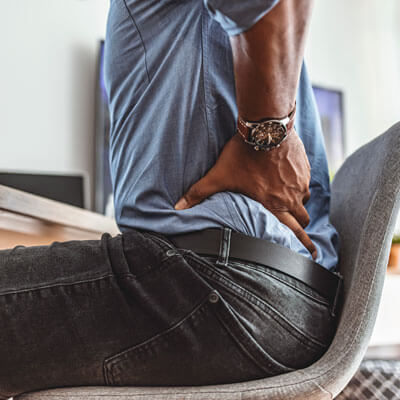Lower Back Pain

Lower back pain, also known as lumbar pain, is a prevalent and often debilitating condition that can affect people of all ages. It is essential to comprehend both the symptoms and underlying causes of lower back pain to effectively address and manage this condition.
Symptoms
Lower back pain manifests in various ways, and the severity and duration can vary from person to person. Common symptoms include:
- Dull Ache or Sharp Pain: Lower back pain often presents as a persistent, dull ache or a sudden, sharp pain. The sensation can be localized to the lower back or may radiate down one or both legs, leading to leg pain and discomfort.
- Stiffness and Limited Mobility: Many individuals with lower back pain experience stiffness in the lower back region, which can restrict their range of motion and make it difficult to bend, twist, or perform daily activities.
- Muscle Tension and Spasms: Lower back pain can lead to muscle tension and spasms in the lower back area, further exacerbating the discomfort.
- Pain Aggravated by Movement: Pain may intensify with certain movements or activities, such as sitting for extended periods, lifting heavy objects, or standing for too long.
- Chronic or Acute Pain: Lower back pain can be either chronic, persisting for weeks or months, or acute, developing suddenly and lasting a shorter duration. Chronic pain often requires long-term management.
Common Causes of Lower Back Pain
Understanding the underlying causes of lower back pain is crucial for proper diagnosis and effective treatment. Some common causes include:
- Muscle Strain: Overexertion, improper lifting techniques, or sudden movements can lead to muscle strain in the lower back, resulting in pain.
- Herniated Disc: A herniated or bulging disc occurs when the cushioning discs between the spinal vertebrae rupture or shift, causing pressure on nearby nerves and resulting in pain.
- Degenerative Disc Disease: As people age, the spinal discs naturally degenerate, leading to reduced shock absorption and increased risk of lower back pain.
- Spinal Stenosis: Spinal stenosis is the narrowing of the spinal canal, often due to age-related changes, which can compress the spinal cord and nerves, leading to pain and discomfort.
- Sciatica: Sciatica results from the compression of the sciatic nerve, typically due to a herniated disc, bone spur, or spinal stenosis. It causes radiating pain down the leg and lower back.
- Scoliosis: Scoliosis, an abnormal curvature of the spine, can lead to lower back pain, particularly in severe cases.
- Arthritis: Conditions like osteoarthritis and rheumatoid arthritis can affect the spine and lead to lower back pain, especially as they progress.
- Injuries: Trauma or accidents, such as falls or car accidents, can cause acute lower back pain.
Book an Appointment
Understanding the specific cause of your lower back pain is essential for developing an appropriate treatment plan. If you’re experiencing persistent lower back pain, it’s advisable to consult a healthcare professional or a chiropractor who specializes in the diagnosis and management of lower back pain. With the right approach, lower back pain can often be alleviated, allowing you to regain comfort and function in your daily life.
CONTACT US

